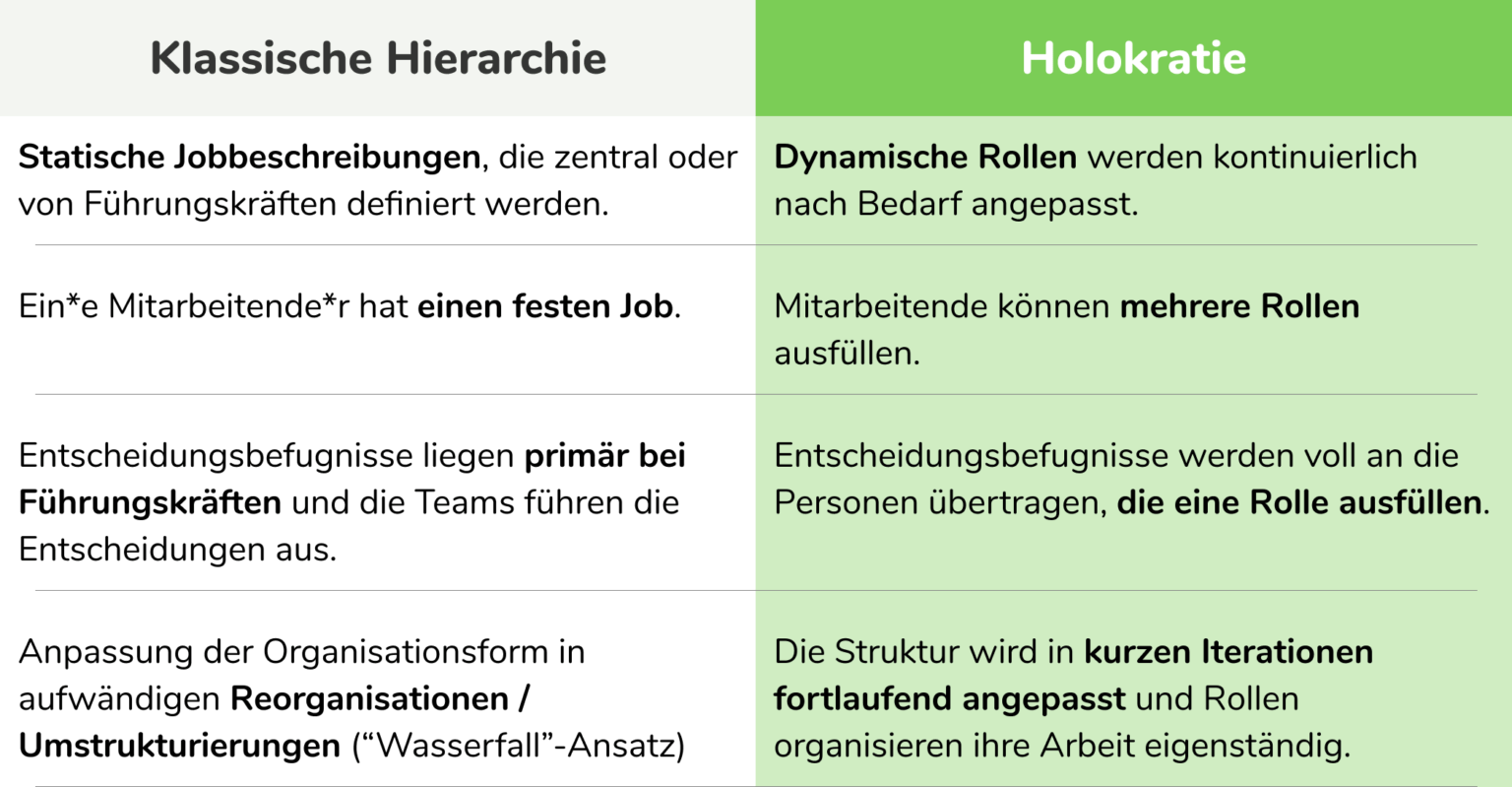Are start-ups really free of hierarchies?
Young start-ups often claim to be hierarchy-free spaces and founders make fun of their friends in other companies when they talk about hierarchical company structures. Well, you better stop laughing because chances are high that you have just as much hierarchy – only less structure.
We have all heard stories about the brilliant founders who, within a few years, created a company from scratch on their own. We think that's nonsense. To be successful, you need an efficient team and not just that one brilliant mind. Spreading myths about brilliant founders repeatedly leads new founders to feel like they have to make every decision in their company themselves in order to prove their “genius”.
A founder is by definition the first employee and therefore has more background knowledge than any new employee. At the same time, the founders are responsible for shaping the vision. As a result, some founders believe that they are the only person who can make decisions.
The founders as a bottleneck
The consequence of this thinking: As soon as the team grows, the founders become the bottleneck in the organization. Few or no employees feel psychologically safe enough to make their own decisions. And when employees do make decisions, they are often overruled by the founders.
Congratulations, you've just created an organization that basically is just as hierarchical and cumbersome as the corporations, that you so like to make fun of. Sure, you don't have any formal hierarchies, but the result is pretty much the same.
Structure, including hierarchy, is not bad per se
Acknowledging that you are part of the problem is an important first step. If founders reflect on their working methods and decision-making processes, they are sure to find situations in which they were the bottleneck – we're not exempt from that.
So what is a solution to this problem? Well, there are many ways to structure organizations. It would be a big mistake to say, “We're a startup, we don't need a structure or hierarchy.” This approach excludes a lot of useful structures that could very well enable your teams and be part of a solution.
At Echometer we did a lot of research on organizational frameworks and found one model particularly attractive: Holacracy.
What is Holacracy?
- Holacracy is an organizational form, that emerged from the sociocracy movement in 2007.
- Instead of teams in an organizational chart, people in Holacracy work in iteratively evolving roles, in which one person can have several roles.
- The HolacracyOne team around founders Brian Robertson and Tom Thomison has one Holacracy Constitution , which serves as the basis for implementation in companies.
- The goal is to increase organizational agility by reflecting the complexity of the business environment in the organizational structure. In this way, the decisions required in the event of changes can be made locally in each role.
- #Fun fact: The inspiration for sociocracy (and thus also Holacracy) comes from observations in nature, more precisely from the octopus (if interested see TED Talk).
Why we chose Holacracy at Echometer
Steve Jobs once said: “There's no point in hiring smart people and telling them what to do; we hire people to tell us what to do."
We were looking for an organizational model that picked up on exactly this idea. We wanted to make sure that every employee understands the purpose and responsibilities of their role. Understanding their role empowers employees to make a large part of everyday decisions themselves – without having to constantly ask permission from one of the founders.
We found that Holocracy enables exactly this: Clear, constantly evolving roles with a clear purpose and freedom to make decisions.
Christian, as the psychologist on our founding team, read about Holacracy in the book Reinventing organizations by Fréderic Laloux . Christian affirmed that the concept of Holacracy is pretty much what Laloux and other psychologists envision as the next evolutionary phase of organizations: self-organized, so-called turquoise (teal) organizations. That sounds exactly like what we had in mind.
How does Holacracy differ from classic hierarchical organizations?

Holacracy is not an easy path
Before we implemented Holacracy, we talked to Raidboxes, a fellow startup from Münster, which has used Holocracy for a few years already. After hearing Johannes' experience report, I was positively impressed and maybe also a little hasty: “OK, that sounds easy. I just write down a list of roles, their purpose and responsibilities, and we're done. "
Well, unfortunately, it's not that simple. While the implementation of Holacracy may offer some low hanging fruits, it is a journey to which a team has to commit. For us this meant that Robin took on the role of the “internal holocracy guru” and prepared the new structures and meeting formats that had to be implemented.
The team reacted with varying degrees of euphoria to the highly structured meeting formats that we would use from now on. With the comprehensive Holacracy Constitution we were all initially a little overwhelmed by new concepts such as “tactical meeting”, “tension”, “triage” – to name just the words that start with T.
Now, around four months after implementation began, we as a team are confident that we are on the right track. We have invested a lot of time to understand the meeting formats and to use them to our benefit.
Holacracy as an investment in the agility of the organization
Still, we don't want to hide the effort that is continuously associated with Holacracy: every new employee will need their time to get used to the format and to thrive in it.
We believe that the – may not be worth the effort now, but even more so in the medium and long term. When our team consisted of only seven people at the time of launch, holocracy still seemed a bit big to us. Due to the small size of the team, we could only guess at many of the problems that holocracy solves. But in the near future, when we grow to 12, 30, or 100 people, holocracy will ensure the scalability of our organization, which was the reason for us to start as early as possible. From other start-ups we heard about "Growth pains" that occur when scaling up. We wanted to be well prepared for those. It was a good sign for us that for example Europace (also one of our customers at Echometer) has been using Holacracy successfully for years with > 200 employees.
Proactively develop the organizational setup
We believe it is a mistake not to develop one's own way of working until the problems become apparent. Instead, think about where your team will be tomorrow. Then initiate changes, right before they are urgently needed. In larger companies, initiating change early is more of a challenge. It's not a coincidence that Kotter's change management model starts with "Create urgency“ as a step in which the "suffering" for teams is made visible in order to create a willingness to change. Start-ups, on the other hand, should aim to act in a more anticipatory and agile manner!
Take the first step towards more agility at an early stage
The constant reassessment of our organizational structure is a core part of holacracy and agile working methods in general. The formats that holacracy provides for this are very stringent and efficient.
At the same time, the Holacracy's formats focus strongly on the formal, organizational structure of a company. From our point of view interpersonal relationships can fall short. Interpersonal relationships are extremely important, especially in phases of transformation. That's why retrospectives ("retros" for short) have proven to invaluable to us as a startup in a constantly changing environment.
In our team retros we share our personal impressions, reflections and worries every week. The resulting common understanding and team spirit is another building block for successful agile work.
Woody Zuill (Agile Evangelist) puts it very nicely in a tweet:

Use team retros in transformation and growth phases
Because of this experience we are proud to develop a tool for retrospectives with Echometer that helps organizations to put teams at the helm of change processes and to focus on the needs and ideas of the team members.
If you are part of an (agile) transformation, it will be worthwhile to book an Online Demo of Echometer.
👉 Your opinion is wanted: Hierarchies & organizational structures in startups
What is your opinion about hierarchies in young startups, scale-ups and mature corporates? Are there any other frameworks that we should get to know? Have you experienced Holacracy yourself and some tips that you can share with us?
We are looking forward to your comments – for example via LinkedIn!








